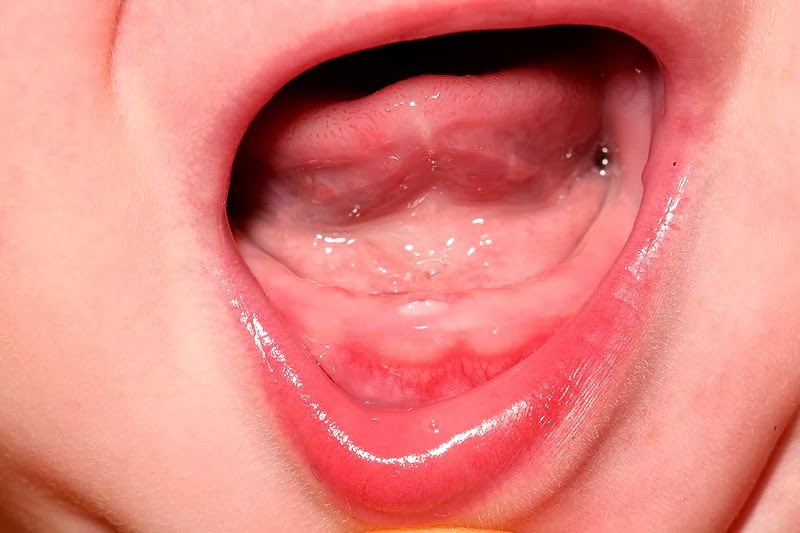This blog has moved to a new website
Nutrition, Health & Wellness
Teething in babies
Earlier, many old remedies like blistering, bleeding and lancing of gums and application of teething powders were tried to help the teeth to "cut" and emerge through the gums. In early twentieth century, many deaths of babies in their first year of life were wrongly attributed to teething and related diseases.The eruption of the tooth is promoted by the periodontal ligament.In fact, there is no 'cutting' of the gum in babies.
 |
| 1.teething in baby |
Baby teething age
Teething in babies generally starts from six months onwards. However there are many exceptions. Primary teeth eruption in some babies may start as early as three months. In some babies it may be delayed up to 18 months. |
| 2. the primary lower central incisor emerging |
Signs and symptoms of teething
- excessive drooling or dribbling by the baby
- urge to bite
- soreness and swelling of the gums
- mood changes
- pain
- mild rash around the mouth
- sleeplessness
- restlessness
- slightly elevated temperature
- pulling on the ears
 |
| 3. Baby with central lower incisors |
Teething problems and remedies
Most of the babies may suffer from pain at least at some stage of the tooth emergence. In rare cases rash may occur around the mouth. There may be slightly elevated body temperature when the teeth emerge out of the gums.Teething pain
The intensity of pain and pain tolerance levels differ among babies. If there is obvious pain and continuous crying, baby-safe pain-relief treatments may be tried under the guidance of a dentist. Chewing cold objects and applying cold pressure on the gum may give temporary relief to the baby. Over-the-counter medicines should not be given to the babies. The risks and adverse effects from inappropriate medication may grossly outweigh the benefits in pain management.
"Aspirin (acetylsalicylic acid) should not be given to babies and teenagers as it may cause Reye's syndrome, a rare but severe illness of brain and liver".
Teething rash
The excessive drooling or dribbling during the teeth emergence may cause rash on the mouth, chin, face and chest. Frequent wiping of the chin and face may prevent the rash. Wiping must be done very gently as frequent wiping itself can cause rash in babies. Petroleum jelly may be applied on the rash for soothing the irritation. It will also function as a barrier cream. Rashes not connected to drooling must be investigated as they may indicate some other illness.
Teething fever
In some babies there may be mild fever when the primary teeth emerge, which can be due to mild gum infections and trauma. It is estimated that 90% of the babies are infected by human herpesvirus 6 (HHV-6) by age two. The infection may take the form of gingivostomatitis causing high fevers and facial rash. If the herpes infection occurs in a baby concurrently with teeth emergence, it is quite often misdiagnosed as teething fever.
Delayed late teething
Delay in teething in babies sometimes runs in families. A pediatric dentist must be consulted if a baby has a toothless grin at 18 months. It could be a very normal delay without any medical condition. If the baby is malnourished and is underweight, the delay could be due to nutritional deficiency, especially of the vitamin D and calcium. Hypothyroidism, a medical condition, causes delayed emergence of primary teeth and delayed walking.
Natal teeth
Some babies have teeth (lower central incisors) at the time of birth. They are known as natal teeth. They are relatively rare, occurring as isolated incidents. Natal teeth do not have root structure, are often wobbly and are loosely attached to the gums by soft tissue. Though generally harmless, sometimes they may be associated with a medical syndrome.Neonatal teething
Neonatal teeth are similar to natal teeth, but emerge during the first month. They may be left in the mouth as long as they are not causing difficulties to the baby or the mother. If the tooth is very loose, there is a possibility of aspiration by the baby and the tooth may be removed by a dentist. Do not try to pull it out as there is the risk of damaging the permanent tooth beds.Milk teeth (deciduous teeth, primary teeth, baby teeth or temporary teeth)
The primary dentition is made up of twenty teeth; four central incisors, four lateral incisors, four canines, four first molars and four secondary molars. From the sixth year they are gradually replaced by permanent teeth. All the incisors and canines are replaced. However the first molars and second molars are replaced by premolars.
Related topics in health and fitness tips:
Peanut allergy.
Chocolate cravings.
Spices for diabetes.
Lysosomal storage disorders.
Loneliness in elderly.
Chronic low back pain.
Pneumonia in elderly.
Blocked tear ducts.
Social anxiety disorder.
Peanut allergy.
Chocolate cravings.
Spices for diabetes.
Lysosomal storage disorders.
Loneliness in elderly.
Chronic low back pain.
Pneumonia in elderly.
Blocked tear ducts.
Social anxiety disorder.
Popular topics in health and fitness tips:
Severe hypothyroidism.
Physical health definition.
Social health definition.
Amla juice.
Dental sensitivity.
Exercise in summer.
Yo-yo dieting.
MRI benefits.
Celery nutrients.
Severe hypothyroidism.
Physical health definition.
Social health definition.
Amla juice.
Dental sensitivity.
Exercise in summer.
Yo-yo dieting.
MRI benefits.
Celery nutrients.
1.http://en.wikipedia.org/wiki/File:Teething.jpg
2.http://commons.wikimedia.org/wiki/File:Teething_2.jpg
3.http://en.wikipedia.org/wiki/File:Baby_teeth_in_human_infant.jpg
1 & 2 images Attribution: Daniel Schwen | License: CC BY-SA 3.0
Image 3 attribution: Chrisbwah | License: CC BY-SA 3.0
Current topic in health and fitness tips: Teething babies
No comments:
Post a Comment